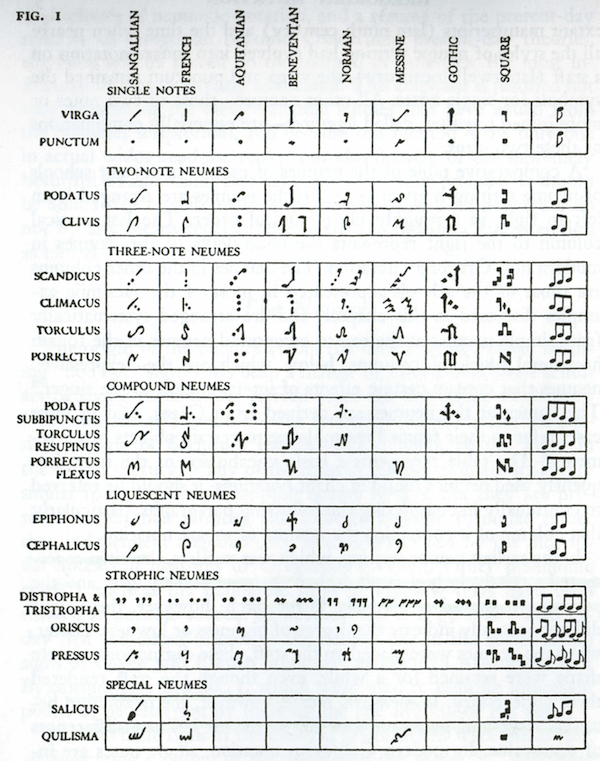6.1. Overview of the Neumes Module 6.2. Module Background 6.3. Neume Notation 6.4. Examples 6.4.1. Basic Encoding 6.4.2. Encoding Variants 6.4.3. Supplied Notes
6. Neume Notation
This chapter describes the elements, model classes, and attribute classes that are part of the MEI.neumes module.
6.1. Overview of the Neumes Module
The module described in this chapter makes available the following components:
6.2. Module Background
Neume encoding in MEI was initially developed as part of the Hildegard von Bingen project at the University of Tübingen. MEI was chosen as the basic representation format after a comparison of existing music encoding formats. The initial work on this module was performed by Gregor Schräder (Ein XML-Datenformat zur Repräsentation kritischer Musikedition unter besonderer Berücksichtigung von Neumennotation), supervised by Prof. Stefan Morent.
This module was originally developed against version 1.8 of the MEI DTD, and has subsequently been translated to the TEI ODD schema.
6.3. Neume Notation
Most neume notation is used to set music to an existing text. The syllable is the fundamental unit of structure, with the neumes themselves serving as a means of “sonifying” the text. A syllable may be expressed via one or more neumes, with the particular neume shape chosen depending on the pitch contour that is being employed and the desired interpretation. For example, two pitches in rising succession might be encoded as a “podatus” (sometimes also called a “pes”), or it might be encoded as two separate punctums, depending on whether it should be sung smoothly connected or with a slight amount of space between the notes.
There are a limited number of possiblities for the most popular musical contours. In general, groups of two to four notes are given unique names, assigned depending on their contour. A “clivis” would be two joined descending notes, while a “podatus” is two joined ascending notes. Table 1 shows most of the named neume shapes. Neume groups of more than four notes are simply called “compound” neumes.

As shown in Table 1, it is possible to have many different styles of neume shapes, derived from local practices of regional groups. In general, these styles are all interpreted in a similar fashion; however, there is evidence that the performance practice of some styles of neume notation differed with regard to rhythm and cadence. This version of the MEI neumes module does not attempt to encode any rhythmic information present in the neume notation. While it may be possible to encode rhythmic values on note elements, this practice is highly discouraged and, if present, should be interpreted as a modern transcription not present in the original sources.
Neume notation existed before the invention of the staff. Staffless neume notation (“adiastemtic”, “cheironomic” or “in campo aperto”) existed primarily as a mnemonic device, reminding performers of the contour of the melody but lacking any absolute pitch information. These neumes were written above the text. With the invention of the staff lines and the clef, “heightened” or “diastematic” neume notation could be used to provide exact interval information. In some cases the staff lines are not actually drawn on the page, but their position relative to an imaginary line and initial clef is consistent.
The syllable element is used as the primary organizational element for neume notation within a layer element. Within syllable, the syl element defined in the MEI.shared module is used for encoding the textual content, while the uneume and ineume elements are used to encode the neumes themeselves. Within these neume module elements, other standard MEI mechanisms are available to accommodate, for example, editorial or critical markup.
6.4. Examples
Some of these examples are excerpts from works of Hildegard von Bingen, with the encoding performed by Stefan Morent and Gregor Schräder.
6.4.1. Basic Encoding
The example illustrates the most basic encoding of neume notation. Encoded here is the opening of Hildegarde’s “O Splendidissima Gemma” with the text “O splendidissima”. Information about the staff has been omitted for brevity, but it was originally encoded on a 5-line staff with two clefs, a “C” and a “F” on lines 5 and 3, respectively.
<layer>
<syllable>
<syl n="initial">
<rend color="red">O</rend>
</syl>
<uneume name="porrectus">
<note oct="3" pname="e"></note>
<note oct="3" pname="d"></note>
<note oct="3" pname="e"></note>
</uneume>
</syllable>
<syllable>
<syl>splen_</syl>
<uneume name="clivis">
<note oct="3" pname="g"></note>
<note oct="3" pname="e"></note>
</uneume>
<uneume name="pes">
<note oct="3" pname="d"></note>
<note oct="3" pname="e"></note>
</uneume>
</syllable>
<syllable>
<syl>di_</syl>
<ineume name="climacus">
<uneume name="virga">
<note oct="3" pname="f"></note>
</uneume>
<uneume name="punctum">
<note oct="3" pname="d"></note>
</uneume>
<uneume name="punctum">
<note oct="3" pname="c"></note>
</uneume>
</ineume>
</syllable>
<syllable>
<syl>dis_</syl>
<uneume name="virga">
<note oct="3" pname="e"></note>
</uneume>
</syllable>
<syllable>
<syl>si_</syl>
<ineume name="scandicus">
<uneume name="punctum">
<note oct="2" pname="a"></note>
</uneume>
<uneume name="punctum">
<note oct="2" pname="b"></note>
</uneume>
<uneume name="virga">
<note oct="3" pname="c"></note>
</uneume>
</ineume>
</syllable>
<syllable>
<syl>ma</syl>
<uneume name="clivis">
<note oct="2" pname="b"></note>
<note oct="2" pname="a"></note>
</uneume>
</syllable>
</layer>6.4.2. Encoding Variants
Variant readings across sources may be encoded. In this example, source “D” has a punctum on the syllable “so” that is not present in source “R”.
<syllable>
<syl>so_</syl>
<uneume name="punctum" xml:id="neumes.d18e">
<note oct="3" pname="g"></note>
</uneume>
<app xml:id="neumes.app1">
<rdg source="#D">
<uneume name="punctum" xml:id="neumes.d19e">
<note oct="3" pname="g"></note>
</uneume>
</rdg>
<rdg source="R"></rdg>
</app>
</syllable>6.4.3. Supplied Notes
In the case of neume notation where no absolute pitch is indicated, you may use the supplied element to indicate an editorially-added pitch. This element’s @source attribute may be used to supply a reference to a source with the absolute pitch provided.
<syllable>
<syl>so_</syl>
<uneume name="pes" xml:id="neumes.d13">
<supplied>
<note oct="3" pname="g"></note>
</supplied>
</uneume>
</syllable>